A case for ICT Regulatory Sandbox
03.04.20231. Introduction
Digital innovations are conquering all fields of everyday life and business, faster than ever before. Similarly, digital innovators, researchers and digital developers are developing new technologies and business models and bringing them to market at a rapid pace. Policy makers and regulators need to not only keep abreast with the pace but also be able to anticipate shifts in the market. Regulators are keeping a close watch on these changes as they need to anticipate the regulatory changes that may be required to facilitate a conducive environment.
Increasingly, regulators need to answer questions like “how can we make good use of the digital opportunities whilst effectively countering the risks?”, and “how do we achieve a balance between access to market for new digital technologies, and consumer safety and market risks?”. Sandboxes are one mechanism that ICT regulators can apply. They can reduce regulatory uncertainty, help emerging innovators, build capacity with and cooperation between regulators, and increase regulatory clarity and compliance.
Regulators have evolved from traditional regulation of telecommunications towards regulating artificial intelligence, Internet of Things, Blockchain, Big Data, neurotechnology, quantum technologies and virtual or augmented realities. Policymakers and regulators are increasingly incorporating new and agile regulatory tools which facilitate a dynamic, evidence-based regulatory environment to test new products, services, and technologies for which existing regulatory framework across varied sectors need to be tested. Over the past years, regulators have emphasized the importance of broadening the legal framework to allow for experimental regimes for innovation that provide a safe space for digital experimentation, such as innovation testbeds and regulatory sandboxes, to allow fine tuning of new business models and foster resilience of future networks and services, as highlighted in the GSR Best Practice Guidelines[1].
Today, nearly a quarter of countries worldwide have created regulatory sandboxes as safe spaces for regulatory experimentation.[2] ICT regulators in Colombia, Mexico, France, Thailand, Saudi Arabia among others have set up regulatory sandboxes as an alternative regulatory tool to fine-tuning new business models, fast-track market entry for small, non-traditional or new players, connect the unconnected, and assess resilience of future networks and services. Others are in the process of doing so. In the Dominican Republic, a new regulation was adopted in 2023, following a consultation process, to promote innovation and enable regulatory testing granting authority to the regulator, INDOTEL, to establish regulatory sandboxes.
Application for sandboxes in various sectors
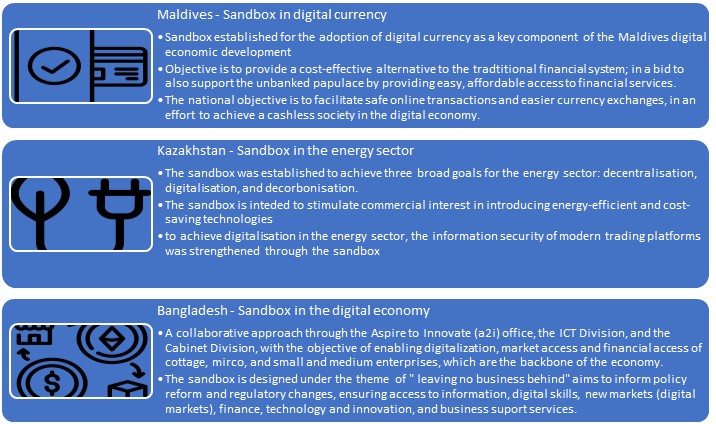
Source: https://www.un.org/development/desa/dpad/wp-content/uploads/sites/45/publication/PB_123.pdf
Regulatory sandboxes provide greater transparency and replicability and are most relevant to markets with good supervisory capacity from the regulating authority and a high level of active, potential non-licensed players that form part of a digital technologies’ ecosystem. This however does not exclude the licensed industry players seeking to expand their product and service offering as we see traditional telecommunications evolving with digital technologies. In creating a balance between digital inclusion and consumer protection, regulators can showcase their willingness to engage with participants and consumers by leveraging regulatory sandboxes.
Additionally, regulatory sandboxes offer a faster route to market and a clearer understanding of the challenges that both regulators and sandbox participants must overcome.
Definitions
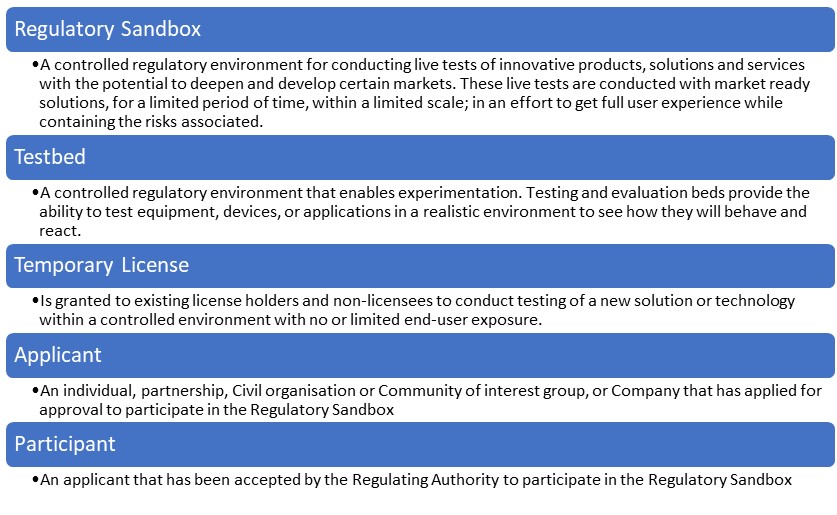
2. Objectives
What is the objective of running a sandbox?
A regulatory sandbox is a regulatory tool designed for developing evidence-based regulations on new digital technologies and innovations; the evidence gathering can assist the regulators and policymakers in mitigating regulatory, security and consumer concerns on the impact of innovations. When establishing a regulatory sandbox, defining objectives from the onset is essential. The objectives inform other Sandbox design components such as, collaborative stakeholder buy-in, expectations, and target implementation. Any objective adopted by a regulatory sandbox needs to be aligned with the regulatory mandate and policy priorities.
There are some general objectives and principles that could apply to any regulatory sandbox and, while there will be some differences between country approaches, these general objectives offer a useful starting point:
- Digital inclusion
- Fast-track digitalization
- Stimulate and support innovation
- Market development and consumer benefit
- Enhance competition and protect consumers
- Economic growth
The image below illustrates a sample of the objectives that have been cited in various regulatory sandboxes implemented in different regions[3]; these are amongst other objectives:
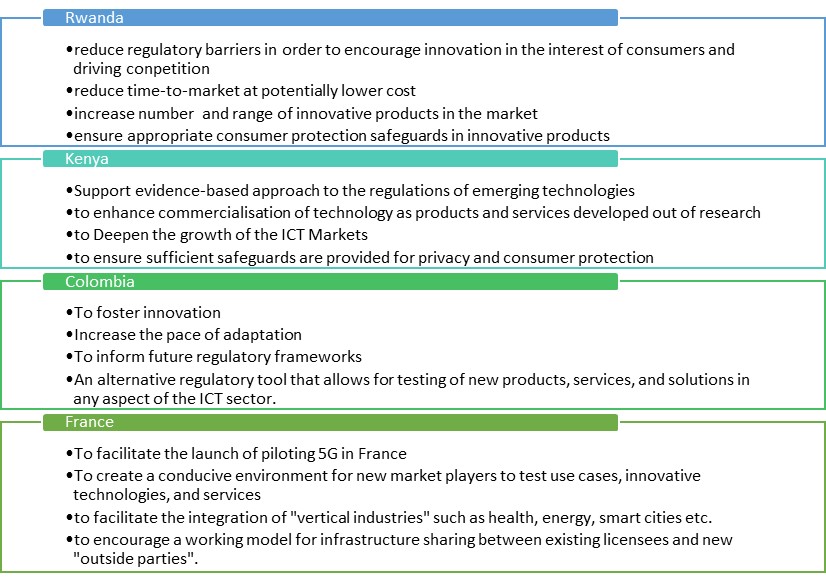
The objectives of the sandbox must be consistent with the legal mandate of the regulator and must be in line with national and global development strategies, such as national development plans, digital strategies, and the United Nations Sustainable Development Goals. The regulatory sandbox also has to align with the national or regional regulatory agendas which advocate for regulatory improvement through innovation. For example, the sandbox can be framed around the objective to fast-track digitalization and digital inclusion; and this would be practically carried out in bridging the connectivity gaps. The regulators’ role in this case is to facilitate agility in regulatory frameworks that will encourage fast and sustainable rollout of broadband connectivity. The sandbox can be used for any regulatory leeway, changes and permissions that would fast track the rollout, and promote uptake. It is the onus of the regulator to ensure that the objectives of the sandbox are clear to all prospective participants and stakeholders; with clear emphasis on what the Sandbox is not intended and cannot be used for. The guiding document for the implementation of the sandbox has to clearly set out the sandboxing duration, and the process of evaluation; and finally the process of making regulatory decision of general application post the sandboxing participation.
Why should regulators establish sandboxes?
Given the benefits resource demand and challenges that come with regulatory sandboxes, regulators should have a clear understanding of the conditions that warrant sandboxing as well as the desired outcome. It is also important that regulators do not abandon the other regulatory tools that have served them over the times, which may be applicable to the innovative solution. The regulatory sandbox decision process illustrated below can facilitate this needs analysis. The decision process is designed to prompt regulators to ask critical questions in scrutinizing the need to sandbox, exploring the underlying hypothesis for adopting a sandbox. Although the decision process is generalized, it is intended to reduce the risk that the sandbox will inadvertently (i) distort the market, (ii) act as an imperfect substitute for other regulatory enablers or frameworks, (iii) create an uneven playing field or, (iv) act as a de facto gatekeeper or substitute for interactions with traditional licensing or regulatory processes[4].
Regulators often cite three main objectives for establishing a sandbox program:
1. Promote innovation and competition
The shortcoming in not interrogating this aspect of sandboxing is that sandbox can be sometimes positioned as a “safe space” to defer the upfront time and expense of licensing until after the participants have demonstrated to investors the commercial viability of the solution.
2. Address regulatory barriers to innovation
This is the most compelling rationale for a regulatory sandbox and the most critical to understanding the comparative advantage of sandboxes over other regulatory tools.
3. Learn about developments in the marketplace
Although this may be a valuable policy objective and help inform the regulator’s viewpoint on the risks and benefits of emerging technologies; this type of learning may be better facilitated through an innovation hub where the costs (time and resources) of it will be borne by the regulator.
The last consideration before sandboxing is to assess the alternatives upon establishing that the main objective to be addressed are the barriers to innovation; the regulator needs to go further in unpacking whether other regulatory tools that are already in use cannot be used in mitigating for the innovation’s success. One of the options is for the regulator to interrogate the cost of compliance, whether it is fit for purpose and how can it be done efficiently. The regulator, together with the potential participant need to interrogate whether there is any ambiguity or uncertainty in the current regulatory framework; and how this can be revised to promote efficiency. Lastly, the regulator and the potential participant need to establish where regulation may prohibit innovation; and in such instances both would benefit from a regulatory sandbox.
The innovation should promise significant new benefit to the market, a first of its kind. That being the case, the regulator needs to ensure that a simple rule change would not enable the innovation and that live testing is indeed necessary for the regulator to learn what changes needs to be made, satisfy safety conditions for end users, and ensure that it will not create an unfair playing field.
The decision tree illustrated below demonstrates the considerations and explorations that guide the regulator when considering establishing the sandbox. All other regulatory tools and options need to be considered alongside the objectives that are to be met; a regulatory assessment to determine the appropriate tool. This ensures that there is regulatory efficiency in the existing regulatory frameworks, and that the sandbox is not trying to reinvent the wheel but rather facilitating for regulations that do not exist.
Figure 1: Regulatory Sandbox Decision Process[5]
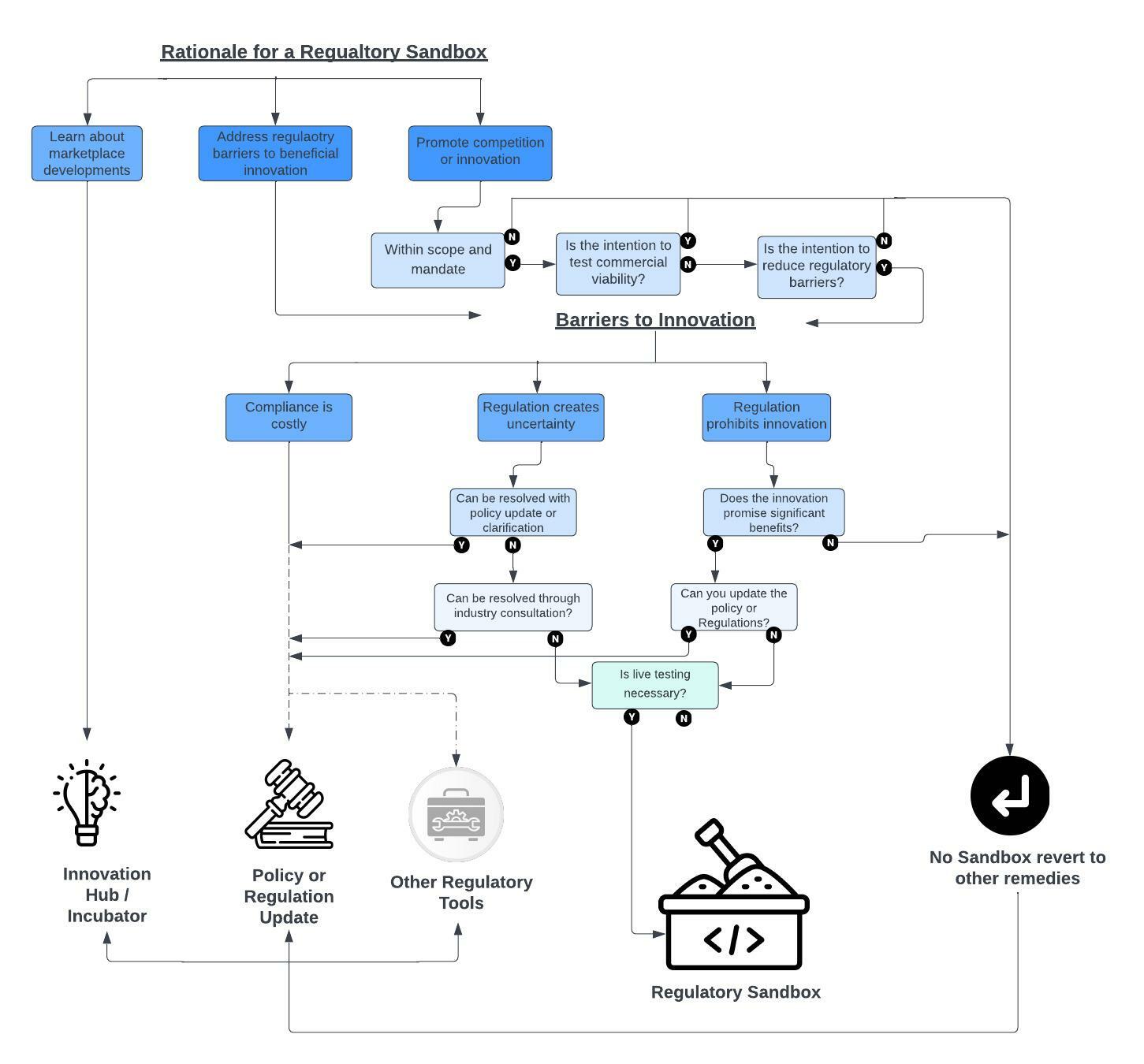
Alternative Regulatory Tools
A regulatory sandbox is specifically designed to provide regulatory clarity for innovators that do not neatly fit within existing frameworks and definitions. A collaborative approach to the regulatory sandbox would mean that the participants therefore have access to several different regulators at the same time to help solve ‘grey matter’ regulatory issues. The regulatory clarity provided, regardless of the regulatory tool, should translate to a participant being able to access the market with greater clarity that is compliant with ‘potential’ regulation. It is important to highlight that there are various alternatives to a regulatory sandbox, the sandbox is not the answer to all regulatory dilemma, and all regulatory tools at hand should be explored as illustrated in the figure above. These include test licenses, innovation testbeds, or innovation hubs; all of which may be applicable options based on the desired objective for each case.
A test license is granted to an existing license holder or a non-licensee to conduct testing of a new solution or technology within a controlled environment with no or limited end-user exposure. The technology or solution being tested could still be under development, unlicensed or not Type approved and would still undergo further enhancements. The outcomes of the test are always shared with the regulator that granted the test license.
The purpose of a regulatory sandbox is to test market ready solutions against regulation, which is different from the purpose of a test license which is intended to test the feasibility and viability of a particular technology or solution for the market. A new solution can go from testing with a test license to a regulatory sandbox where it will ascertain security and market fit in a regulatory context[6].
An innovation testbed or hub is an initiative to help startups and large companies leverage intellectual capacity to nurture new ideas, generate business models and concepts, and develop new technologies. Innovation testbeds facilitate collaboration between various agents, companies, and authorities, in an environment where there is a vast exchange of information, knowledge and strategies to develop joint solutions or develop new technologies.
A regulatory sandbox is not an incubator innovation. Solutions that enter the sandbox must be market ready and control tested; when they enter the sandbox the focus is on whether the new technology or solution will fit into the existing regulatory framework and what regulations need to be adjusted to meet this new solution[7].
The literature on innovation testbeds and regulatory sandboxes does not consistently differentiate these terms. One may argue that a regulatory sandbox is a specific type of an innovation testbed where the control element are the regulatory conditions. In fact, all regulatory sandboxes are innovation testbeds, but not all innovation testbeds are sandboxes. The Organisation for Economic Co-operation and Development (OECD) classifies testbeds as “testing environments (or test beds), where new technology developments can be tested in controlled but near to real-world conditions.” Examples given include a testbed programme introduced by the UK’s National Health Service (NHS) in 2016 in partnership with industry to allow testing of new innovations and new approaches to service delivery facilitated by digital technologies, with the aim of making successful innovations available to the NHS and care providers around the country. The OECD distinguishes these from regulatory sandboxes, which provide waivers from regulation, allow companies to trial new products, and allow regulators to learn as well. They are said to “help identify and better respond to regulatory breaches and enhance regulatory flexibility”[8]. The Inter-American Development Bank refers to testbeds as programmes that provide access to physical or virtual environments in which companies or the public sector stakeholders can test, develop, and introduce new products, services, processes, organizational solutions, and business models. They consider that innovation testbeds tend to be led by one executive agency, require heavy investment in setting up new or improved virtual infrastructure and have a strong R&D element[9].
3. Policy Considerations
Digitalization and technical advances have propelled development to unprecedented levels; bringing to the center the potential of innovation and forward-looking solutions which have great potential to accelerate the achievement of the global development agenda through the 2030 Sustainable Development Goals. The rapid scaling and evolution of digital technologies does present new risks, threatening the very development of governments and end-users; threats such as data breaches, digital fraud, privacy, and cybersecurity could undo all efforts.
The increased uptake and use of frontier technologies can also further widen the digital divide, leaving behind the unconnected and digitally illiterate, which has cascading impact on social, economic, and digital cohesion. There needs to be a deliberate policy and regulatory framework to accelerate digitalization, which is in turn supported by institutional arrangements and collaborations which spur growth while mitigating risks.
The table below illustrates clear drafting into policy and regulatory positions which promote digital transformation; the countries cited below have all made declarations in policies towards digital transformation which support the establishment of a sandbox. The countries listed below have all established a regulatory sandbox and have done so based on enabling policy and legislation in place or in the process of adoption. One of the great imperatives of regulatory sandboxes is the commitment of policy makers and implementers; when embarking on sandboxing, clear leadership within government and inter-agency cooperation are critical in reaping the learnings and growth. A highly engaged, cooperative and collaborative approach will facilitate better informed and evidence-based policy and regulatory decisions.
| Country | Policy Reform or Legal Prescript |
| Rwanda | The final draft regulations governing the regulatory sandbox in Rwanda cites Article 129 of Law No. 24/2016 of 18/06/2016 which governs Information and Communication Technologies. Paragraph 7 empowers the regulators to: “encourage investment and innovation in information and communications technologies, for the promotion of electronic transactions”[10]. |
| Kazakhstan | The government, through collaboration between the Artificial Intelligence Fund (AI Fund) and the Ministry of Digital Development, Innovation and Aerospace industry have introduced a legislative framework through a draft bill for the use of experiments and sandboxes, referred to as an “experimental regime”, to further promote innovation and digitalization[11]. |
| Singapore | Singapore is transforming itself into a Smart Nation through its Digital Strategy. The Smart Nation Strategy is anchored by three pillars, digital society, digital economy, and the digital government. As part of the Digital Economy pillar, the Strategy highlights the importance of regulatory agility through sandboxing[12]. |
| Colombia | Law 1955 of 2019 includes general references on digital transformation, and the mandate to generate spaces for innovation, in the regulation. This served sectors such as Finance, Telecommunications, among others, to explore and open regulatory sandboxes to promote innovation. The development of new businesses and innovation was the focus of this inclusion, in the law of the development plan 2018-2022. The Telecommunications/ICT sectors and the financial sector took advantage of this standard to generate their own sandbox regulations. |
| Kenya | Launched a public consultation on the framework for emerging technologies regulatory sandbox. The framework has since been published, and the regulator is awaiting legislative amendment to support the regulatory sandbox. |
Regulatory sandboxes are intended for truly novel technology and solutions whose success would broadly serve the public interest and economic growth. They are also driven by what policymakers and regulators can learn, potentially guiding future regulations and legislation. The use of a structured and interactive process of information sharing drives transparency and promotes agility. Regulatory sandboxes differ on how directly their learnings are applied to policy; from the regulator directly triggering a pre-legislative consultation on a specific regulatory change, to providing contextual information to the ongoing evolution of policy discussions.
The governments capacity to operate a sandbox will in turn strengthen the digital capacity of institutions and regulators. Building an institutional culture across government and agencies of sandboxing could facilitate more open and active dialogues with innovators, increasing agility and responsiveness[13]. As highlighted in the GSR-20 Best Practice Guidelines on Gold standard for digital regulation; multiple formats and modes of regulation should be considered where traditional regulation needs to create space for self-regulation, hybrid and collaborative regulatory models, as well as oversight mechanisms for law enforcement. The new technologies, product and services that are coming in market require novel approaches which expand the regulatory toolbox to include regulatory sandboxes, ethical frameworks, technology roadmaps, regulatory impact assessment, multi-varied research, and big data simulation[14]. Sandboxes can break down policy and regulatory barriers to bringing digital technologies for development; they further ensure that digital technologies are inclusive by design from the onset. It is important to plan deliberately from the onset for inclusion, this actively mitigates the biggest threats of digital technologies – the widening of the digital divide.
4. Digital Regulatory Sandbox Framework
Establishing a Regulatory Sandbox
Establishing a regulatory sandbox involves a few steps which coordinate the interaction between the regulator, ICT innovators, and other stakeholders. The stages involve design and conceptualization of the regulatory sandbox, clear operational parameters, and a post implementation analysis and considerations.
Figure 2: Regulatory Sandbox Framework
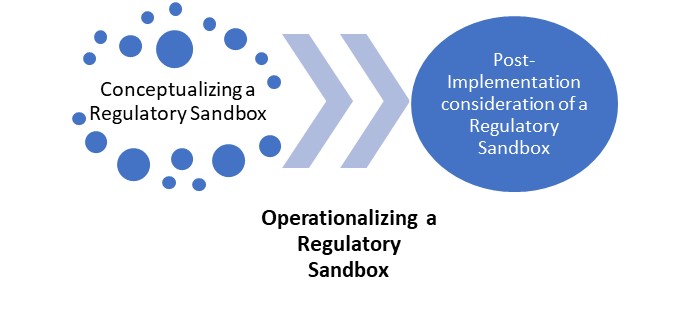
Source: Guide for Launching Regulatory Sandboxes for Innovative Finance. 2020[15]
The conceptualization and design of the sandbox is critical in that it sets the tone with regards to transparency, eligibility, stakeholder collaboration and resource capacity. The governance framework and the institutional structures will greatly influence the objectives of the regulatory sandbox; as well as informing the collaboration and stakeholder engagement. It is critical that the regulator invest time through consultation while mapping the stakeholder engagements and establishing collaborative frameworks with other regulators. The regulation and use of digital technologies is a cross cutting function of various sectors of the economy; digital technologies are also vertically integrated; the regulator, therefore needs to adopt a collaborative approach to sandboxing where it can leverage resources, and insights from other regulators.
Once the stakeholder and collaborative framework have been designed, the team capacity and resources can be explored amongst all stakeholders and regulators involved. The regulatory sandbox requires significant resource commitment due to the nature of the sandbox operations and the oversight that is required of the regulator. Lastly, in the conceptualizing phase, the regulator needs to explicitly set out the eligibility criteria, and the timeframes for application processes, participation in the sandbox and exiting the sandbox[16].
Once the concept of the sandbox has been designed, validated by stakeholders, and approved; the regulator is now set to operationalize the regulatory sandbox. Bearing in mind the objectives of the sandbox in collaboration with stakeholders, the regulator is ready to kick start the application process. The submission and evaluation of applications must be transparent and publicly communicated to hold both the participants and regulator accountable. Once the participants have been selected and begin sandboxing; the regulator has the responsibility to guide and provide oversight to the participants throughout the sandboxing period constantly and consistently. The regulator during this period will also be in constant contact with external and internal advisors who are subject matter experts; the regulator could very well at this point also be gaining insight and knowledge from observing. The strength of the collaborative framework is tested in this phase, as it may be necessary to form a multi-regulator team to oversee the sandbox; in which case clear memoranda of understating need to be in place[17].
The last phase, and the most critical for knowledge transfer and meeting the primary objective of the regulatory sandbox, is the post-implementation considerations. The participants of the sandbox would have agreed prior to starting on how they would exit the sandbox and all the deliverables on findings would be shared with the regulator. The regulator will also analyze the data collected and structure its own learnings and insights. The outcomes would be communicated with all relevant stakeholders, and any changes that need to be made to the existing regulatory framework would be premised on the outcomes report of the sandbox.
5.Conceptualizing the Sandbox
Regulatory Sandbox Design
The design of a regulatory sandbox begins with a thorough needs assessment that is linked to the overall objectives of the program. The assessment helps identify the resources required; align internal and external stakeholders and highlight complementary regulatory bodies. The feasibility assessment should confirm institutional commitment to the sandbox by identifying an executive sponsor and a tentative governance structure. A key critical success factor for a regulatory sandbox is the regulators’ ability to demonstrate clear and unambiguous commitment at the highest level. The table below illustrates some of the key elements of regulatory sandbox design that can be applied to achieve the design requirements of a regulatory sandbox.
Table 1: Regulatory Sandbox Design Elements
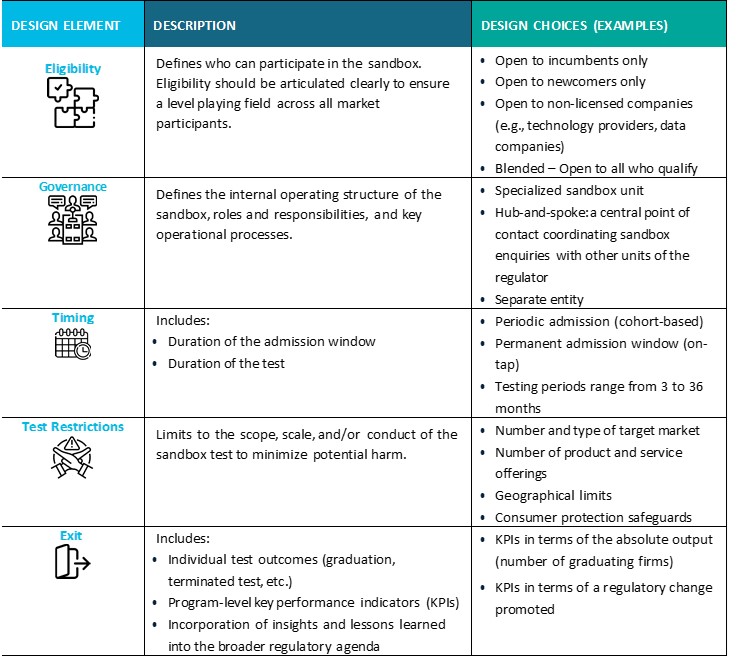
Source: Guide for Launching Regulatory Sandboxes for Innovative Finance. 2020[18]
Below are some examples of how existing regulatory sandboxes have been designed; the examples are a selection of various sandboxes that have been researched.
 Eligibility |  Governance |  Timing |  Test restrictions |  Exit Options | |
| Kenya | All who are keen to pilot innovative technology solutions | Communications Authority of Kenya – ICT Regulator led | 12 months, renewable for another 12 months |
|
|
| Saudi Arabia |
| The Communications, Space & Technology Commission (CST) – ICT Regulator | 9 months
Extendable by 12 months |
|
|
| Rwanda |
| Rwanda Utilities Regulatory Authority-–
which is the regulator that is responsible for all utilities including ICT in Rwanda | Up to 24 months |
|
|
| Colombia | 4 selection criteria:
| Communications Regulation Commission – ICT Regulator led | 12 months, renewable for another 12 months | Safeguards plan defined with each project and depending on the type of innovation. Geographical, legal restrictions, etc. can be defined. They are not pre-set. |
|
Minimum Threshold for Consideration
The regulatory sandbox cannot be designed in a policy vacuum, it should reflect the national legal and regulatory frameworks, the local market conditions, and the current regulatory capacity. A sandbox is a formal program, as such it must align to the regulators statutory mandate as well as other existing legal and regulatory frameworks. In cases where there is a misalignment or policy gap; there first needs to be a provision in the policy or regulatory framework to guide the implementation. In some cases, the regulator may be legislatively authorized to establish a sandbox, as is the case of the Capital Markets Authority Act in Kenya (section 12A); other may be able to pursue a legislative change to grant such authority as was the case in Colombia, Mexico and Spain.
A vibrant national digital technologies market is not a prerequisite or justification for a regulatory sandbox; if the objective is indeed to stimulate innovation; where there is little innovation a sandbox may be introduced to stimulate local innovation. It is, however, important to assess the local demand to appropriately design the sandbox in anticipation of applications and testing volumes.
The needs assessment of the regulatory sandbox must include a transparent evaluation of capacity, which mostly is defined in terms of resources that can be committed to the sandbox over a few years. An internal capacity review should assess:
- Whether the sandbox will include dedicated or shared staff model; this can be shared staff from other participating regulators.
- Technical skills for program management, market engagement, technology assessment, test design and administration, and inter- and intra- regulator coordination.
- Interactions with other regulatory tools and programme such as innovation hubs, licensing processes, etc.[19]
Resources committed range from several thousand-dollar commitments annually to million-dollar commitments, depending on the monetary commitment at hand. Most regulators do not have these resources to expend on a new project; this is where the multi stakeholder model comes into great use. A shared services model may be the most feasible way to carry out a regulatory sandbox[20].

The following main areas of the sandbox design must be considered as these have a direct impact on the success and efficiency of the sandbox; conceptualization includes analyzing and identifying the following main areas:
- Governance structure of the sandbox
- Team capacity and resources
- Regulatory collaboration and stakeholder engagement
- Regional and international harmonization
- Eligibility criteria – who can participate
- Validity period
- Safeguards to be in place for participants and the regulator
- Sandbox exit
These areas of focus would form part of what is commonly known as the guiding document or implementation framework for the regulatory sandbox. The guiding document will effectively be what the regulator uses to operationalize the Regulatory sandbox. The guiding document is drafted by the Regulator and the stakeholders, with input from industry participation; it is thus the regulators document that sets out operational parameters.
Governance
The minimum threshold for consideration discussed in the section on establishing a sandbox, the legal framework, market conditions, and capacity; will help to determine who should be responsible for implementing a regulatory sandbox, how much resources are available, who else should support the sandbox (external and internal), when and how it should function.
It is important that the regulatory sandbox satisfy all legislative requirements and approvals required to establish a regulatory sandbox from the outset. The operations and objectives of the regulatory sandbox flow from the legislative and regulatory framework, and the governance structure outlines who the lead regulator will be, how they will collaborate with other regulators, how the sandbox will be capacitated and resourced[21].
Figure 3: Governance framework

Source: Policy Impact partners and Pygma Consulting[22]
Team Capacity and Resources
The operationalization of a regulatory sandbox is widely considered to be demanding on both time and skillset required of the implementing regulator. The operations of a regulatory sandbox require a dedicated team that would be responsible for the operations including the evaluation of application forms, assessing complex innovation, testing plans and performance metrics, supervising the Sandbox participants, all while keeping abreast with technological developments within the sector. The resources operating the sandbox are also responsible for keeping the stakeholders updated on the operations of the sandbox.
Prior to the establishment of the sandbox, the first consideration must be to assess the existing resources, their availability, and capability to run the operations of the Sandbox. If the sandbox will be established as part of a cross-sectoral collaboration between regulators, the resourcing could be established with a dedicated cross functional team to the sandbox operations. The stakeholder management is an important relation to uphold throughout the existence of the sandbox, however, this function can be resource intensive as it requires periodic communication, oversight, and supervision of stakeholders.
The most common model for resourcing and staffing the sandbox is to have a small number of fully dedicated staff members running the sandbox operations. This dedicated team of resources is then supported by additional policy, legal, and technical subject matter experts working in the regulator’s other departments. The dedicated staff that work on the sandbox need to be subject matter experts as well, and not just carrying out an administrative function as this would soon become an additional burden on the support staff in the regulator who would need to divide their efforts between their primary role at the regulator and the sandbox[23].
The regulatory sandbox staff, as well as their network of advisors and consultants must have a deep understanding of digital technologies, the ICT sector, and its business models; further to this they must understand the underlying varied sector specific applications and use that might require the need for sandboxing. The regulator should have access to, amongst others, the following areas of expertise, be it internally or through its network of stakeholders:
- National and international policy expertise
- National and international regulatory expertise
- Digital Technology / Digital Engineering Expertise
- Cybersecurity and Consumer protection
- Data Analytics
- Innovation and Future studies
It is important that the dedicated team, as well as all regulators involved in the regulatory sandbox keep abreast with the fast-growing developments within digital technologies and other technology driven sectors. It is also highly recommended that the team dedicated to the sandbox capacitate themselves extensively through peer learning with other regulators or specialized skill programme[24].
Regulatory Collaboration and Stakeholder Engagement
The critical success factor in developing a regulatory sandbox is to identify the achievable and reasonable objectives that are aligned to the Country’s priorities, such as economic growth, digital inclusion, and the development of a knowledge economy, which also address the needs and challenge faced by the ICT sector.
Sandboxes are usually hosted by the sector regulatory authority in the country; however, with the cross cutting and enabling nature of ICTs it is increasingly possible that the ICT regulator would be the host regulator while working alongside other sector regulators. The regulator hosting and running the sandbox would ideally have power of authority through a memorandum of understanding on all the key sectors expected to participate in the sandbox[25].
Coordination with both internal and external stakeholders is necessary when several regulators are involved; regardless of the form that it takes – whether it be a memorandum of understanding, a joint committee, or an informal information exchange- there should be a process in place to cover at least the instances where a sandbox applicant or participant fall under the mandate of a different regulator.
Figure 4: Digital Ecosystem of Stakeholders
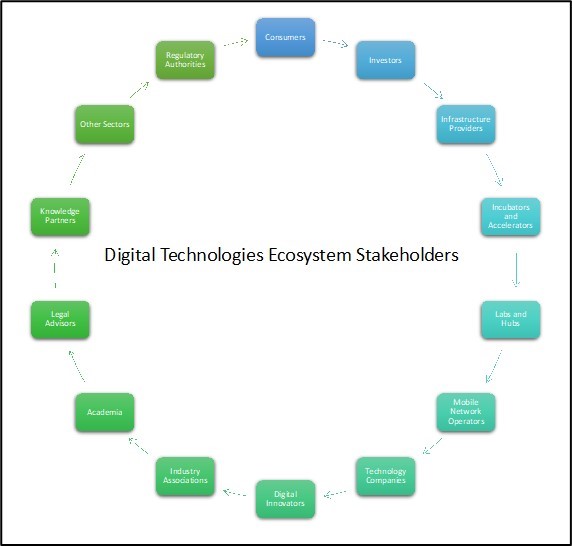
Source: Policy Impact Partners and Pygma Consulting. 2022[26]
The ecosystem illustrated above demonstrates the wide network of stakeholders that form part of the digital ecosystem. Depending on the objectives of the sandbox, some or all stakeholders would form part of the stakeholders’ ecosystem in the sandboxing. The Stakeholder engagement is an important aspect of the regulatory sandbox design and implementation; it requires the regulator or regulators involved to craft a detailed and thorough stakeholder engagement plan and matrix. In crafting the stakeholder engagement plan there are three main groups of stakeholders that the regulator needs to be cognizant of: the market participants, internal stakeholders, and peer regulators.
The market participants’ consultation process needs to cover two aspects of the sandbox. The sponsor regulator is the regulator that will be responsible for the implementation and hosting of the sandbox. The sponsor regulator, in collaboration with other participating regulators, should engage the market participants to understand both the nature and scope of innovation activities and the need for regulatory modernization. This will assist the regulator in framing a hypothesis for the regulatory sandbox; or in some cases refute the need for a sandbox completely. This engagement will help identify emerging trends and technologies that would fall into the realm of the regulators scope and mandate. Once the regulator has satisfactorily established the need to establish a sandbox and has a clear understanding of the market trends and technologies, as well as the regulatory shortcomings that exist in the current framework; the regulator should consult the marketplace on the sandbox design. The consultation on sandbox design would shed light on ensuring that there are no barriers to participation for future participants. The design element consultation should cover aspects around application fees, protection of intellectual property shared during the testing, the sandboxes intended purpose and eligibility criteria. Clarifying the purpose of the regulatory sandbox during this consultation process will later improve the quality of the application process and help avoid wasting time and resources in a process that is intended to deliver regulatory outcomes and not commercial advice or capital investment[27].
The second consultation that the sponsor regulator should conduct is with internal stakeholders; this is key staff both in the hosting regulator and the other supporting regulators. This consultation is the beginning of the memorandum of understanding as it is intended to build alignment and support for the project.
The last critical consultation is with other regulators that have overlapping or adjacent jurisdictions or mandates. Digital technologies are enablers to many sectors, and cuts across various jurisdictions which are also regulated; financial regulators and ICT regulators are the most obvious collaborators. With digital technologies, the regulatory landscape is not as linear and delineated as it used to be, it has increasingly become a complex environment; it is of considerable importance that regulators collaborate and coordinate to ease regulatory ambiguity.
Cross Boarder Collaboration
Regional and international harmonization are not new concepts to converged regulatory frameworks; even as regulation evolves harmonization and knowledge sharing are still very central to new regulatory tools. The digital environment is global in nature, users can, in most jurisdiction, view content from anywhere in the world. With the increased use in digital technologies, we see people work, collaborate and shop across the globe. The globalization of it all regardless of the location raises concern for governments in addressing cross-border issues and risks such as data privacy, consumer protection, national security, and public safety, among others[28]. The asymmetries in legislation and regulations makes it difficult to regulate across jurisdictions; harmonization through regional regulatory standards become the best option for cross boarder collaboration. We have seen this in the European Union with the establishment of the General Data Protection Regulation policy for the protection of data and promotion of privacy. Harmonization frameworks and international cooperation instruments are at the core of sound digital transformation strategies; these are essential to regulating the flow of data and personal information as well as sharing knowledge and insights.
The Digital Regulation platform cites the Asia-Pacific Economic Cooperation, which is an economic forum composed of 21 member states focused on ensuring cross-border trade. This Cooperation adopted the APEC Cross Boarder Privacy rule system which seeks to balance the flow of data and information[29]. A similar cross boarder collaborative instrument can be adopted for cross boarder collaboration in the implementation of regulatory sandboxes, where a standard is set for collaboration and sharing of information. This framework will assist the regulators to foster faster learnings, be able to mitigate developing risks and share knowledge insights from the regions, while also promoting the protection of personal data.
There are three ways in which cross boarder collaboration can be approached, any one or all three of the approaches below apply. Regional regulatory associations play an important role in cross-border regional collaboration and harmonization. Regional bodies often facilitate the implementation of such cross-border collaborations; through the three approaches below[30]:
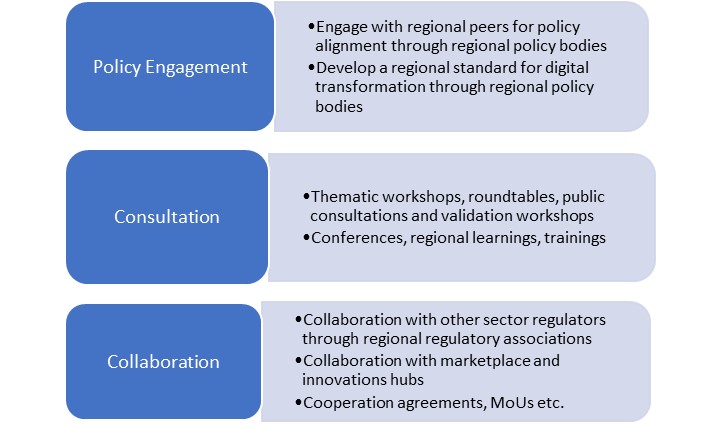
Eligibility Criteria
It is important for the sponsor regulator which will lead and host the implementation to set criteria for decisions regarding applications to employ the regulatory sandbox. The application should contain the necessary supporting information to explain how the sandbox evaluation criteria listed below can be fulfilled:
- Innovation: “Is it a genuine innovation?” The proposed service/solution includes new or emerging technology or uses existing technology in an innovative way. For example, secondary research should show that few or no comparable offerings are available in the market.
- Consumer benefit: “Is there a consumer benefit?” The proposed service addresses a problem or brings benefits to consumers and/or industry. This contention could be supported by evidence from relevant consumer or industry research.
- Need for a Sandbox: “Is there a need to sandbox?” Establishing the need to sandbox using the decision-making process (Figure 1 copied below):
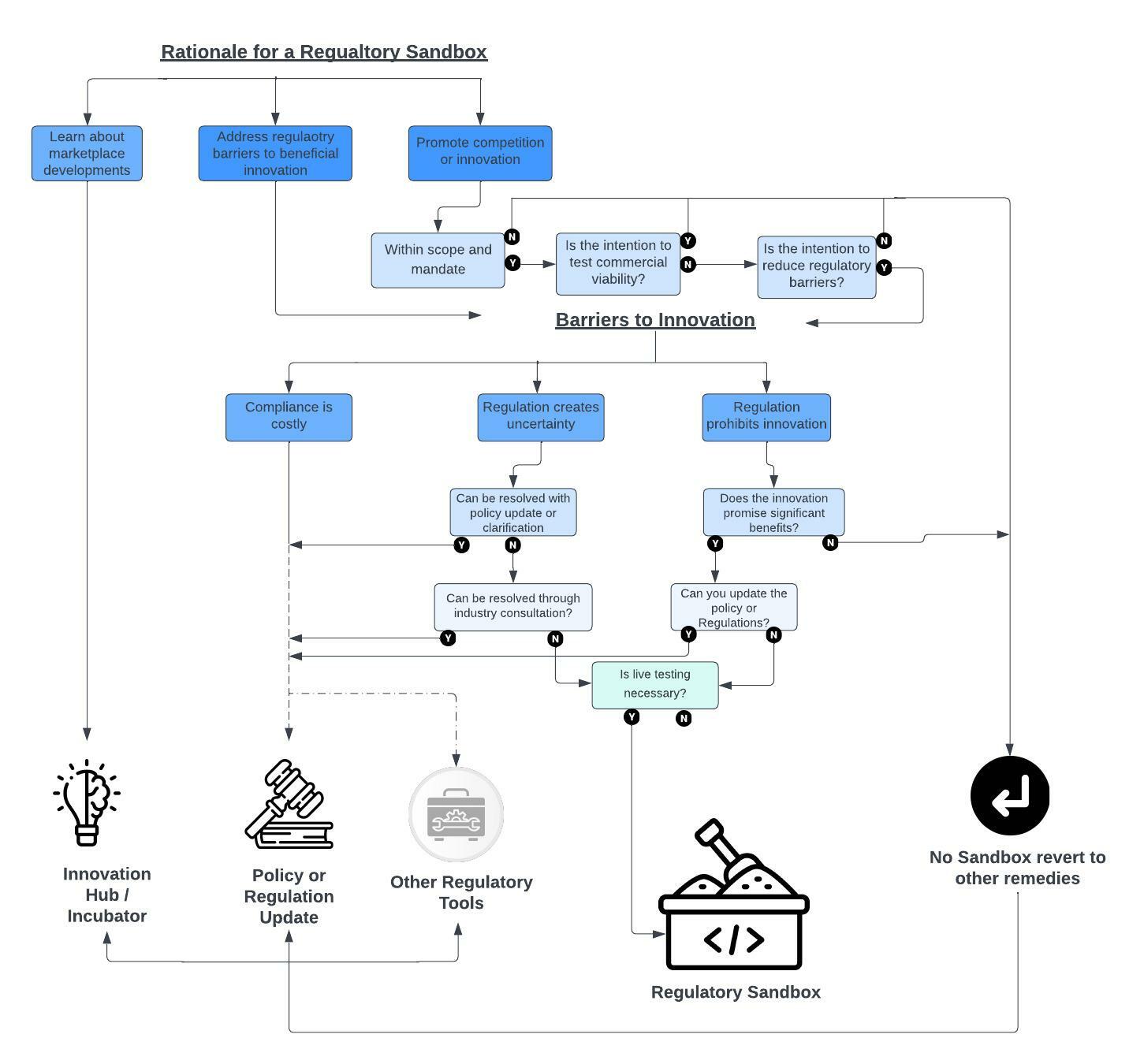
- Test readiness: “Is the innovation ready to be tested?” The test scenarios and expected outcomes of the sandbox experimentation should be clearly defined, and the sandbox entity should report to the regulatory authority on the test progress based on an agreed schedule.
- Consumer protection: “Is this innovation secure by design?” The appropriate boundary conditions should be clearly defined, for the sandbox to be meaningfully executed while sufficiently protecting the interests of consumers and maintaining the safety and soundness of the industry.
- Risks and mitigation: “Does it entail any risk?” Significant risks arising from the proposed service should be assessed and mitigated. For example, providing evidence of preliminary testing of the proposed service as part of the sandbox application, identifying the risks discovered from the preliminary testing and the proposal for mitigating the risks; and
- Exit strategy: An acceptable exit and transition strategy should be clearly defined from the onset; exploring various outcomes that would lead to the exit[31].
Validity Period
The regulator may issue a license to ‘play’ in the sandbox, after satisfying the application criteria. The testing period or ‘time to play’ in the regulatory sandbox are bound by the parameters set out by the regulator in the application process. This is usually anything from three (3) to twenty-four (24) months; and extensions can be granted on prior application and motivation.
At the end of the validity period, the player will exit the sandbox and if eligible, they will migrate to the full authorization and supervisory regime in the current regulatory framework of the regulatory authority. During the validity period, the regulator will engage with and support the player and ensure that the player operates within the parameters as set and agreed on prior to the grant of the ‘license to play.’[32]
Safeguards
An absence of ordinary regulatory parameters and requirements does not invalidate the need for basic safeguards to all participants playing in the sandbox as this can lead to regulatory arbitrage or can lead to the sandbox being used a vehicle of forbearance by others. The following requirements are general safeguards that can be elaborated upon by each regulator depending on their framework[33]:
| Safeguards and Requirements | |
|---|---|
| Fit and Proper requirements | The players should be able to demonstrate their ability to perform their roles and properly manage the operations of the tested innovation. |
| Consumer Protection | “Safety by design” the innovation should inherently be built for the protection of consumers and end-users, ensuring that consumer rights will always be protected. |
| Quantitative limits | A clear criterion set for the maximum number of customers in the sandbox test. |
| Reporting requirements | A detailed framework on the reporting of the test progression, consumer status, interim results, reporting frequency and methods; amongst others. |
Operationalizing the Sandbox
Once the conceptualization of the regulatory sandbox is complete, the regulator is now ready to implement and operationalize the sandbox from the application process through to the exit of the sandbox. The duration of each stage is decided by the regulator informed by the regulator’s capacity and availability of resources. The following chart depicts the different stages of the operations of the regulatory sandbox.
Regulatory Sandbox process Chart[34]
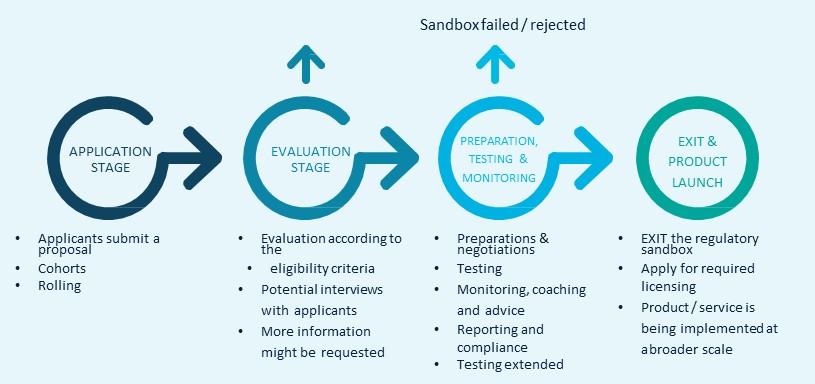
Application Stage
The regulator, depending on its capacity, resourcing, and capabilities, will adopt one of two models for how it receives applications. The two most common models are:
- Cohorts: The regulator runs an application window periodically. The number of cohorts in a year is decided by the regulator and determined by the regulator’s capacity and resourcing. The regulator can also make use of the “Invitation to Apply” approach, where invitation is issued periodically.
- Rolling: The regulator does not have a particular application window, but rather applications are accepted throughout the year and applicants are welcome to submit applications at any time in the year.
The application forms are intended to play two significant roles in maintaining consistency in the regulatory sandbox application process. The application form supports the regulator in determining whether the innovation qualifies to be considered to participate in the sandbox, it further serves as the participants commitment to the sandbox parameters. Every application is to be evaluated against the regulatory sandbox’s objectives and eligibility criteria as defined in the founding document.
The regulator should further publish a guidelines document for the applicants to follow while filling the application form. These guidelines should provide examples of the positive and negative indicators of each section of the form. In general, the application form will have the following key sections:
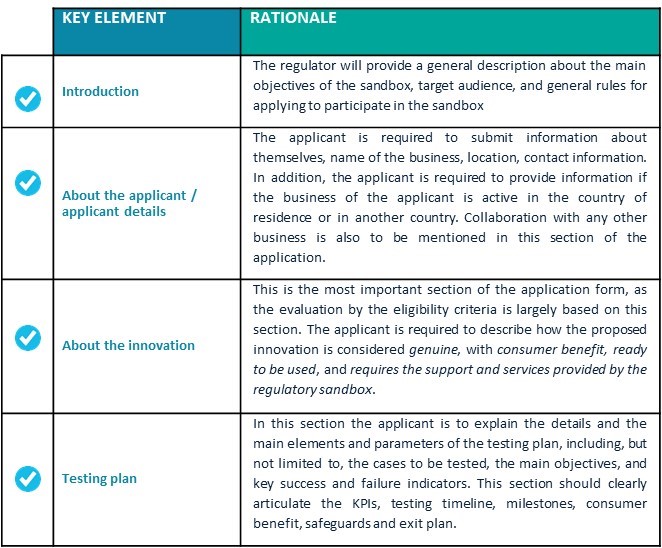
Source: Guide for Implementing Regulatory sandboxes[35]
Evaluation Stage
The regulator will, for the purposes of transparency, establish an evaluation committee to assess all submitted applications. The committee should review the applications against the pre-defined eligibility criteria. The scores and weights of each criterion will be set by the regulators and published in the application guiding document.
During the evaluation process, the committee has the right to call the applicant for presentation/interview to further discuss the innovation, its business model, and product offerings, to better understand the need for ‘sandboxing’. At the discretion of the regulator, the applicant may be allowed to review and modify the application and resubmit.
It is important that the evaluation and approval process be time bound, and that this is adequately communicated in the guiding document. This will ensure that the regulator has sufficient capacity and is well resourced to deal with the complexities of various innovations. Generally, applicants will be informed about the regulator’s decision within twenty-one (21) days of the submission. Research shows that the standard turnaround time is around 21 days, both Kenya and Rwanda state a turnaround period of 21 days. Singapore has three offering for sandbox participation all of which offer different turnaround times. Below is an illustration of Singapore’s offering[36].

Similarly, after approval, the applicants will be prescribed the time frame within which to start testing the innovation. The regulator must align with existing regulations and legislation on timeframes and the technicalities of the duration, such as working days or calendar days.
The regulator should have an independent tribunal or appeals board where applicants to the sandbox may appeal the outcome of their applications should they not be favorable. Following the outcome of the application, the applicant may appeal an unfavorable decision with the Tribunal / Appeals Board and the outcome of this appeal must be delivered to the applicant within a reasonable timeframe from the day of appeal[37].
Preparation Stage
Once the applicant has successfully passed the evaluation phase and been approved for testing, the applicant now becomes a ‘participant’ or ‘player’ in the regulatory sandbox. Prior to the commencement of testing, the regulator and the player will work together and co-create the sandbox plan that should cover the topics shown in Figure 5 below.
Figure 5: The sandbox plan[38]
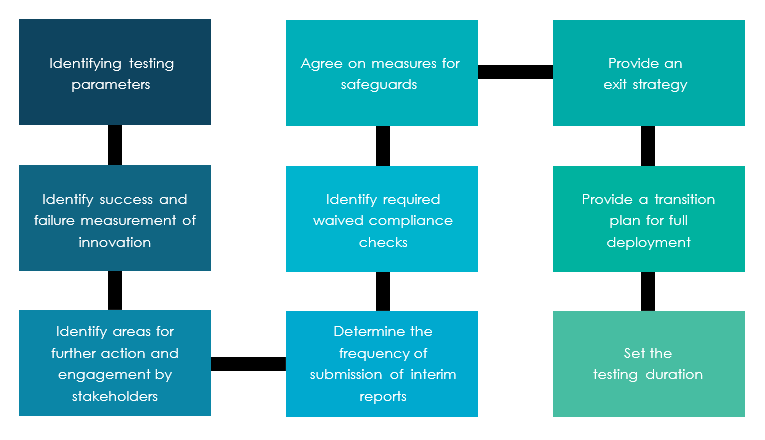
Sandbox Agreement
A sandbox agreement between the regulator and the players is critical for governing the relationship between both parties. A contractual arrangement checklist that can be used by the relevant parties in provided below[39].
Testing and Monitoring Stage
During this stage, the regulator upholds the parameters of the agreement by ensuring that the player only tests the innovation according to the agreement. As per the agreement and sandbox plan, the regulator in collaboration with the relevant stakeholders will provide direct supervision and mentorship to the regulatory sandbox participants. Ideally, each participant will have an assigned officer to ensure that appropriate safeguards are being implemented and there is no breach in any of the pre- agreed parameters.
The dedication of an assigned officer ensures that the regulator can provide guidance and oversight as the testing continues. It also means that there is continuous monitoring which would allow for corrective actions, solutions, and interventions in a timely manner. The officer may also identify required waivers that were not pre-conceived in the sandbox plan or agreement[40].
Reporting and Approvals
As part of the sandbox plan and the agreement, the sandbox participants are required to submit interim and final reports to the regulator. This is in line with the objectives which will assist the regulator in identifying required interventions and support for the sector. The interim and final reports shall cover the information shown in the table below[41].
| Dispute resolution | Operational aspects | Business aspects |
| · Frequency and nature of incidents/complaints · Incident/complaint resolution mechanisms | · Operational issues · Corrective actions | · Active users & frequency of use · Qualitative factors |
Interim Reports
The sandbox agreement shall set the frequency of the interim reports, and this will be determined in consideration of the testing duration, complexity of the innovation, and risks associated with the test. Interim reports are to include the following information:
- Key performance indicators, key milestones, statistical data;
- Key issues arising as observed during the testing period;
- Action required to address the issues;
- Required intervention and waivers by the regulator[42].
Final Reports
As part of the sandbox agreement, sandbox participants are obliged to submit a final report to the regulator detailing all findings, test results and challenges. This report will assist the regulator in improving the regulatory landscape to accommodate similar innovative products in the future. The analysis of findings in final close out reports form a critical element in sandboxing as the learning paves the way towards the implementation of general regulations that are evidence based and informed by technological changes. For example, the regulator can review existing regulations to definitively eliminate restrictions or create new regulations.
In Colombia the regulation that was established, resolution CRC 5980 of 2020, includes the following as the routes to be taken at the end of the experimentation period:
- An agreed upon exit plan is implemented,
- The implementation of new regulations,
- General authorizations is contemplated, or
- The elimination of regulation.
A successful test will produce:
- Main outcomes of the test, KPIs, comparative outcome analysis;
- Customer feedback, complaints, concerns, and challenges during the testing period. Measures taken to overcome the challenges;
- A detailed description about the technology and network limitations, consumer protection and risk management frameworks;
- A summary of recommendations and findings to the regulator about the testing experience.
- Next steps that can be taken by both the participant and the regulator.
Failed Test Report
In the case of a failed test, the learnings can be very important to the regulator. The report for such instances should include the following additional information, over and above the points mentioned above:
- Lessons learnt from the test;
- Reasons for failure and how these failures were addressed / determined;
- Customer feedback and response to the innovation.
Exiting the Sandbox Stage
How participants of the sandbox exit the sandbox is equally as important and the details and guidelines on how to enter and participate in the sandbox. To exit the regulatory sandbox, a participant has three options: early termination, scheduled termination, or an extension. These three options can be accessed whether the sandbox test is deemed successful or not.
Early Termination
In the event the sandbox test is successful, this does not mean that the participants’ product or service is immediately allowed into the market. A product/service may be allowed into the market after the regulator has compared it to its mandate and if the product/service is market worthy. Figure 6 below indicates all possible scenarios regulators can use to determine the market readiness of a product/service.
Revoking approval and discontinuing testing
The regulator reserves the right to revoke approvals to participate in the sandbox at its reasonable discretion, and subject to providing sufficient reasons to the relevant participant(s) for revocation, should the testing violate certain measures that may be pre-set or identified by the regulator during the testing period[43].
FIGURE 6: Exiting a sandbox (all possible scenarios)[44]

Scheduled Exit
This is an automatic process upon reaching the maximum duration within the sandbox and is the ideal scenario for most participants. Further criterion can be attributed to the fulfilment of any outstanding obligations to customers. At this stage, the participant will submit the final report to the regulator. At this point the regulator, having reviewed the reports and research insights gathered, will consider if any changes are required in the existing regulatory regime or if new regulatory regimes are required based on evidence provided through sandboxing. Part of the objectives of the sandbox is to facilitate a safe and fast entrance to the market for new products and innovations; the regulator therefore needs to ensure that post-sandboxing the regulator creates an enabling regulatory environment for compliant product launch. Then, finally, the sandbox participant decide whether to launch the new solution within the frameworks set out below; this is not an exhaustive list of options[45]:
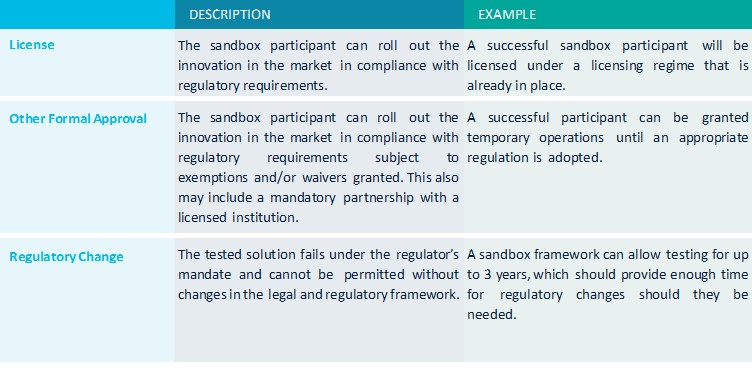
Extensions
Before the termination date of the sandbox, the participant could apply for an extension based on a justifiable reason. However, it is not always an available option. An extension will be issued on a case-by-case basis, based on the request of the sandbox entity. The duration of the extension can be set according to a restriction in length or be milestone driven.[46].
Risks and Considerations
The implementation of a regulatory sandbox inherently has some limitations and risks associated with it, all of which could result in adverse consequences for the consumer. As the regulator’s primary mandate is generally to protect the consumer, these risks need to be mapped and mitigated as far as possible. These risks need to be identified and borne by the regulator, as well as the sandbox players. Therefore, these risks need to be constantly monitored and considered from conceptualization, operationalization, and finally at reporting and exiting the sandbox.

Benefits
The potential benefits of a regulatory sandbox include the following[47], but are not limited to:
 Reduced time-to-market | Uncertainty and delays in regulatory landscapes adversely affect the first movers of innovation; the successful testing that can result from participation in a regulatory sandbox reduces the overall time to introduce products in the market. |
 Better access to funding and investment | Most digital innovation is heavily reliant on investments, especially in the form of equity. Innovation attracts lower valuations as investors factor in the risk of clarity in the ambit of regulation and compliance. Sandboxes facilitate ease of investment as product viability and regulatory compliance has been tested. |
 Facilitates more innovative products | Regulatory uncertainty can pose as a barrier to entry for innovators as testing in live markets can prove to be expensive. The sandbox framework provides comfort in managing regulatory risks during the testing stage. |
 Reduces compliance costs Reduces compliance costs | Compliance costs can be a deterrent to startups and small enterprises. Sandboxes serves as accessible launch pads for safe testing within the legal and regulatory barriers but free from the burden of commercial competition. |
 Regulatory clarity Regulatory clarity | The sandbox is a collaborative effort between the regulator and the participants, this facilitates discussion on the various outcomes of the sandbox experimentation. This helps regulators and the participants to understand the potential future changes in regulations. |
 Limited Failure Consequences | The sandbox environment allows for participants to test out its product whilst making sure the impact of product or service failure is minimal on consumers. Customer protection also ensure that no major leakage happens during the testing phase. |
Risks
Below are some of the risks that the regulator may encounter while implementing the regulatory sandbox.
Regulator’s Capacity
- Limited human capital to run and manage the operations of the regulatory sandbox efficiently and effectively.
- Poor selection of sandbox participants due to limited technical capacity of the regulator to assess the technology underlying the innovation.
- Limited authority possessed by the regulator to conduct and perform required regulatory reforms.
| The regulator should have the full authority to make or advocate for regulatory reforms. Furthermore, the regulatory sandbox should be operated by a skilled and dedicated team that will run and manage its operations. |
Unfair Competition
Participants of the sandbox enjoy some regulatory and compliance relief for certain aspects of compliance due to the waivers and relaxed conditions of the sandbox. As compliance can be costly for licensees, this is a strong incentive to participate in a sandbox. But there needs to be a balance struck by the regulator in this regard. The regulator needs to ensure that there is no perception of unfairness from those not participating in the sandbox.
The sandbox participants receive guidance and advice from other stakeholders that will advance their innovation. This could potentially create the perception of anti-competitive practices where the regulator enhances the market potential of one player to the exclusion of those who do not participate in the sandbox.
| To address any negative public perceptions, the regulator should enhance transparency around the following key areas: 1. Sandbox objectives 2. Eligibility criteria, 3. Awareness and promotion about the sandbox operations, and 4. The separation of functions within the regulator to demonstrate an impression of objectivity in market and competition sensitive innovations. |
Reputational Risks
Restrictive or outdated regulatory regimes may thwart the level of innovation and participation in the sandbox. This will result in the regulator not assessing the applications appropriately, and thus rejecting more applications or not approving the right kind of innovation to realize the growth envisioned.
Another risk arises with liability on the regulator’s part in the case that failed tests result in harm to customers and other market participants. This could be perceived as poor supervision by the regulator which might threaten the regulator’s reputation and customer trust in the sector.
6. Conclusion
The rapid advances of digital technologies, and their convergence needs to be matched with robust and well-informed regulatory approaches. To maximize the benefits of digital technology innovation, countries need to implement a stable and nimble regulatory ecosystem that can facilitate innovation while safeguarding consumers. An adaptive policy making infrastructure that is suited to address evolving complexities that come with the advancement of digital technologies is imperative for the successful establishment of a regulatory sandbox. The macro-economic impact of a regulatory sandbox and a supporting policy landscape leads to developing a workforce equipped with the needed expertise to fully participate in a digitally enabled future.
In an increasingly convergent age of digital technologies, forming diverse and effective collaborations with a broad group of stakeholders such as those in the digital technologies ecosystem is important to achieving the objective of the sandbox.
Regulatory sandboxes are an alternative regulatory tool that allows regulators access to live testing, recent digital technology products and services, and provides relevant information in understanding the evolution of technology. The focus on innovation sets regulatory sandboxes apart from existing regulatory tools, the way it is also implemented ensures that the regulator has full exposure and can learn from the participation. Regulatory sandboxes require that the regulator have direct supervision, which provides data, research and insights for the regulator to regulate more effectively. The regulator will always have the interest of the consumers or end users, and Sandbox innovations provide solutions that better the lives of consumers, increase market offering and access to digital technologies.
The implementation principles set out in this article are a guide to be applied according to the legal and policy context of every country.
References
- See GSR Best Practice Guidelines 2019 on “Fast forward digital connectivity for all”; GSR Best Practice Guidelines 2020 on “The gold standard for digital regulation”; and GSR Best Practice Guidelines 2021 on “Regulatory uplift for financing digital infrastructure, access and use”. ↑
- A total of 47, according to analysis based on the G5 Benchmark 2021. ↑
- https://rura.rw/fileadmin/Documents/ICT/Laws/Final_Draft_Regulation_Governing_the_Regulatory_Sandbox_in_Rwanda_v2.0.pdf
https://www.ca.go.ke/framework-for-emerging-technologies-regulatory-sandbox-january-2023/
https://digitalregulation.org/case-study-regulatory-sandbox-framework-in-colombia/https://en.arcep.fr/news/press-releases/view/n/5g-16.html ↑
- Jenik,Ivo and Schan Duff. 2020. How to build a regulatory sandbox: A practical guide for Policymakers. CGAP ↑
- Jenik,Ivo and Schan Duff. 2020. How to build a regulatory sandbox: A practical guide for Policymakers. CGAP ↑
- Jenik,Ivo and Schan Duff. 2020. How to build a regulatory sandbox: A practical guide for Policymakers. CGAP ↑
- Jenik,Ivo and Schan Duff. 2020. How to build a regulatory sandbox: A practical guide for Policymakers. CGAP ↑
- Digital Innovation: Seizing Policy Opportunities | READ online (oecd-ilibrary.org) ↑
- Regulatory Sandboxes and Innovation Testbeds: A Look at International Experience in Latin America and the Caribbean | Publications (iadb.org) ↑
- https://rura.rw/fileadmin/Documents/ICT/Laws/Final_Draft_Regulation_Governing_the_Regulatory_Sandbox_in_Rwanda_v2.0.pdf ↑
- https://www.un.org/development/desa/dpad/wp-content/uploads/sites/45/publication/PB_123.pdf ↑
- https://www.smartnation.gov.sg/about-smart-nation/pillars-of-smart-nation ↑
- https://www.un.org/development/desa/dpad/wp-content/uploads/sites/45/publication/PB_123.pdf ↑
- https://gen5.digital/best-practices/the-gold-standard-for-digital-regulation/ ↑
- Guide for Launching Regulatory Sandboxes for Innovative Finance. Support to an enabling Business Environment for MSMEs Development & Financial Inclusion. 2020 ↑
- Jenik,Ivo and Schan Duff. 2020. How to build a regulatory sandbox: A practical guide for Policymakers. CGAP ↑
- Jenik,Ivo and Schan Duff. 2020. How to build a regulatory sandbox: A practical guide for Policymakers. CGAP ↑
- Guide for Launching Regulatory Sandboxes for Innovative Finance. Support to an enabling Business Environment for MSMEs Development & Financial Inclusion. 2020. ↑
- Jenik,Ivo and Schan Duff. 2020. How to build a regulatory sandbox: A practical guide for Policymakers. CGAP ↑
- Jenik,Ivo and Schan Duff. 2020. How to build a regulatory sandbox: A practical guide for Policymakers. CGAP ↑
- Guide for Launching Regulatory Sandboxes for Innovative Finance. Support to an enabling Business Environment for MSMEs Development & Financial Inclusion. 2020. ↑
- A proposed Regulatory Sandbox Framework for Africa. Policy Impact Partners and Pygma Consulting. 2022 ↑
- Jenik,Ivo and Schan Duff. 2020. How to build a regulatory sandbox: A practical guide for Policymakers. CGAP ↑
- A proposed Regulatory Sandbox Framework for Africa. Policy Impact Partners and Pygma Consulting. 2022 ↑
- Jenik,Ivo and Schan Duff. 2020. How to build a regulatory sandbox: A practical guide for Policymakers. CGAP ↑
- A proposed Regulatory Sandbox Framework for Africa. Policy Impact Partners and Pygma Consulting. 2022 ↑
- A proposed Regulatory Sandbox Framework for Africa. Policy Impact Partners and Pygma Consulting. 2022 ↑
- Digital Regulation Platform. 2020. ITU https://digitalregulation.org/cross-border-collaboration-in-the-digital-environment-2/ ↑
- Digital Regulation Platform. 2020. ITU https://digitalregulation.org/cross-border-collaboration-in-the-digital-environment-2/ ↑
- A proposed Regulatory Sandbox Framework for Africa. Policy Impact Partners and Pygma Consulting. 2022 ↑
- Jenik,Ivo and Schan Duff. 2020. How to build a regulatory sandbox: A practical guide for Policymakers. CGAP ↑
- A proposed Regulatory Sandbox Framework for Africa. Policy Impact Partners and Pygma Consulting. 2022 ↑
- Guide for Launching Regulatory Sandboxes for Innovative Finance. Support to an enabling Business Environment for MSMEs Development & Financial Inclusion. 2020. ↑
- Guide for Implementing Regulatory Sandboxes for Innovative Finance: https://www.euneighbours.eu/sites/default/files/publications/2020-12/MED%20 MSMEs%20Programme%20-%20Regulatory%20Sandbox%20Guide%20-%20Nov.%202020.pdf ↑
- Guide for Implementing Regulatory Sandboxes for Innovative Finance: https://www.euneighbours.eu/sites/default/files/publications/2020-12/MED%20 MSMEs%20Programme%20-%20Regulatory%20Sandbox%20Guide%20-%20Nov.%202020.pdf ↑
- https://www.mas.gov.sg/-/media/mas-media-library/development/regulatory-sandbox/mas-fintech-regulatory-sandbox-framework.pdf ↑
- Guide for Implementing Regulatory Sandboxes for Innovative Finance: https://www.euneighbours.eu/sites/default/files/publications/2020-12/MED%20 MSMEs%20Programme%20-%20Regulatory%20Sandbox%20Guide%20-%20Nov.%202020.pdf ↑
- A proposed Regulatory Sandbox Framework for Africa. Policy Impact Partners and Pygma Consulting. 2022 ↑
- A proposed Regulatory Sandbox Framework for Africa. Policy Impact Partners and Pygma Consulting. 2022 ↑
- Guide for Implementing Regulatory Sandboxes for Innovative Finance: https://www.euneighbours.eu/sites/default/files/publications/2020-12/MED%20 MSMEs%20Programme%20-%20Regulatory%20Sandbox%20Guide%20-%20Nov.%202020.pdf ↑
- Guide for Implementing Regulatory Sandboxes for Innovative Finance: https://www.euneighbours.eu/sites/default/files/publications/2020-12/MED%20 MSMEs%20Programme%20-%20Regulatory%20Sandbox%20Guide%20-%20Nov.%202020.pdf ↑
- Guide for Implementing Regulatory Sandboxes for Innovative Finance: https://www.euneighbours.eu/sites/default/files/publications/2020-12/MED%20 MSMEs%20Programme%20-%20Regulatory%20Sandbox%20Guide%20-%20Nov.%202020.pdf ↑
- A proposed Regulatory Sandbox Framework for Africa. Policy Impact Partners and Pygma Consulting. 2022 ↑
- A proposed Regulatory Sandbox Framework for Africa. Policy Impact Partners and Pygma Consulting. 2022 ↑
- Ibid ↑
- Didenko, A. 2019. Exit From A Sandbox And Next Steps: https://events.development.asia/system/files/materials/2019/04/201904-exit-sandbox-and-next-steps.pdf Date of Access: 5 Dec. 2021. ↑
- Regulatory Sandbox. Making India a Global Fintech Hub. July 2017. – https://www.deloitte.com/content/dam/Deloitte/in/Documents/technology-media-telecommunications/in-tmt-fintect-regualtory -sandbox-web.pdf ↑